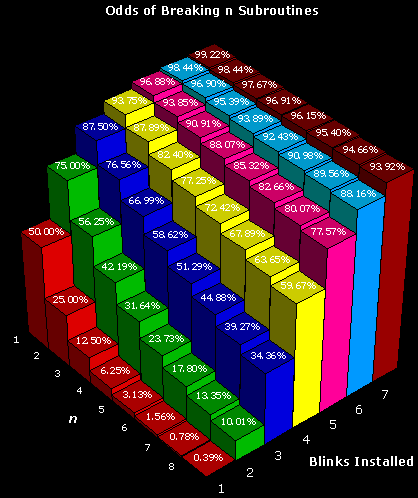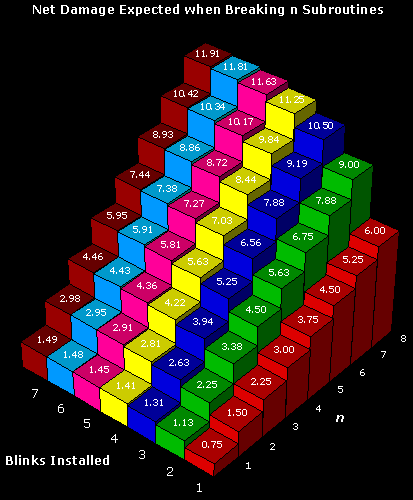-
Dropp is always good for running early. You can force the Corp to spend its bits to rez ICE that you can't possibly break yet. Dropp is also useful for revealing the type of ICE. In a Blink deck, however, the type of ICE doesn't matter, so Dropp loses some of its charm.
Force Shields can save you from a lot of early damage. A Banpei or Marionette. will stop you cold, though. Otherwise, this is like Dropp with a little more risk involved.
Enterprise, Inc., Shields are a great match for the Blink plan anyway. They require money, but can also save you from a Bolter Cluster. In this case, Banpei can be crippling because you will need this program for the whole game.
The last thing to consider is how much risk you want to take breaking any particular subroutine. The more Blinks you have available, the better chance you have of breaking a subroutine. Here is a chart:

Pick your number of Blinks based on how many subroutines you think you will be facing on a particular run, and how badly you need to break them.
How Much Damage?
If you use Blink, you are going to take Net damage. Developing a scheme to handle that damage is key. Choosing a scheme involves balancing the speed of your setup and the amount of damage you are willing to take. Here are the statistics on the amount of damage you can expect to take:
Here are some plans for dealing with the damage:
-
"Green Knight" Surge Buffers are a favorite. They are free to install, and you can tap them like lands in Magic as you use them during a run (you even get an untap phase at the start of each turn). If you are planning on making more than one run each turn, make sure and include enough Surge Buffers to handle the extra runs. You might also consider throwing a few Cortical Stimulators into the mix as an alternative to breaking brain damage subroutines.
the downside is that it takes a lot of actions to install enough Surge Buffers to really feel safe.
Weefle Initiation is great unless the fort is too big. It's a one-shot, so plan on getting it back or including enough copies in your deck to handle all your runs. MIT West Tier is nearly indespensible here, as is Junkyard BBS. Another downside is that if you play Weefle Initiation at the start of each run, you can't play any other preps that might be useful.
Shields are the old standard from B.P. (Before Proteus). They require MU, though, so you will need to plan on including some Imps, Afreets, or Mem Chips. It might be smart to throw in a few Force Shields as an alternative to breaking brain damage subroutines.
Enterprise, Inc., Shields are the modern favorite. The good news is that they are always working. The bad news is that you always need money to use them. Half of the attraction of Blink is that it is free. If you are going to play with EI Shields, it isn't free anymore. This is also the only solution which comes in a single card, which can really reduce your setup time.
How Many Bits?
Blink is a free breaker, but the cost associated with its failure can be high. Plus, you are always going to want to trash Nodes and Upgrages. Choosing a method to generate bits involves balancing your damage prevention, card trashing, and trace and tag prevention against the efficiency of your card drawing and actions.There are tons of traditional bit engines that can really work for you in this stack. They include Score!, Livewire's Contacts, Organ Donor, MIT West Tier, Loan from Chiba, and Lucidrine Booster Drug. I don't recommend any of these, they defeat the whole purpose of playing with Blink (free runs!). You might as well replace your Blinks with Bartmoss and Joan and go full-cheese ahead.


